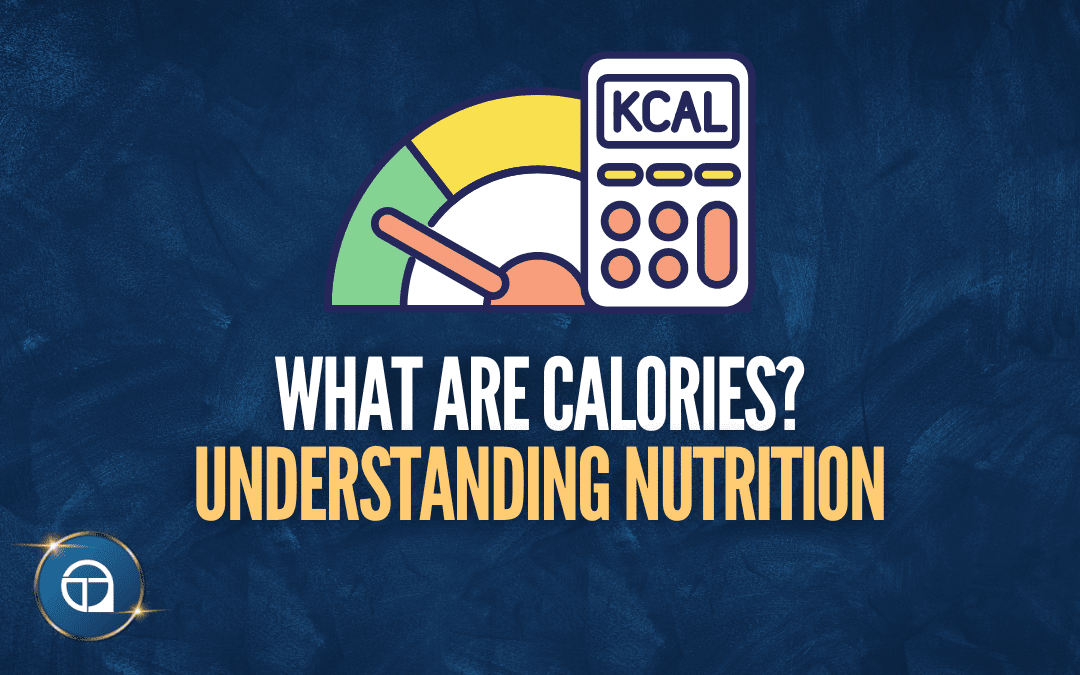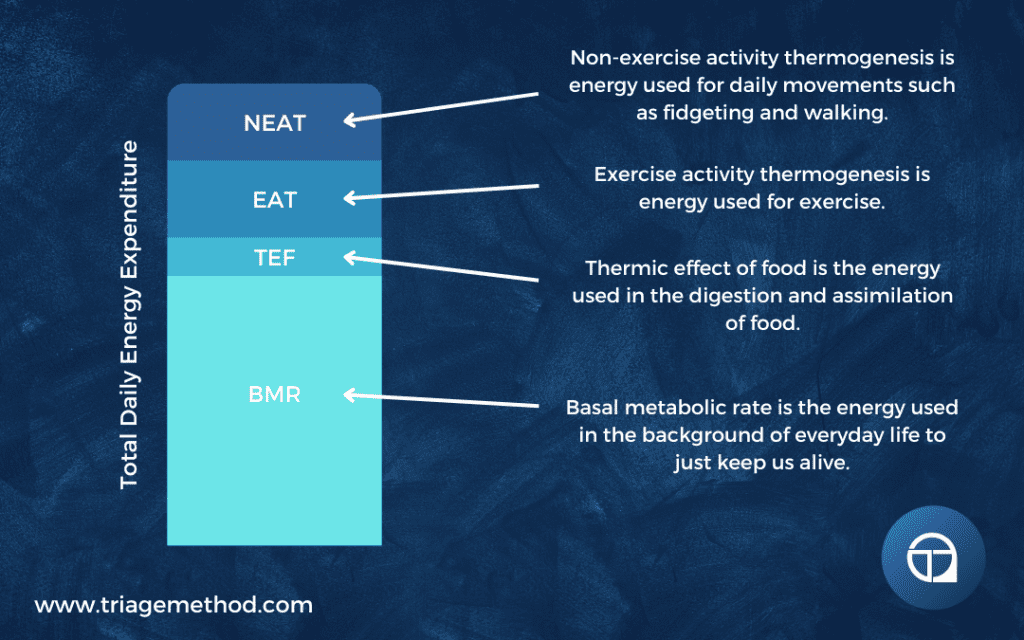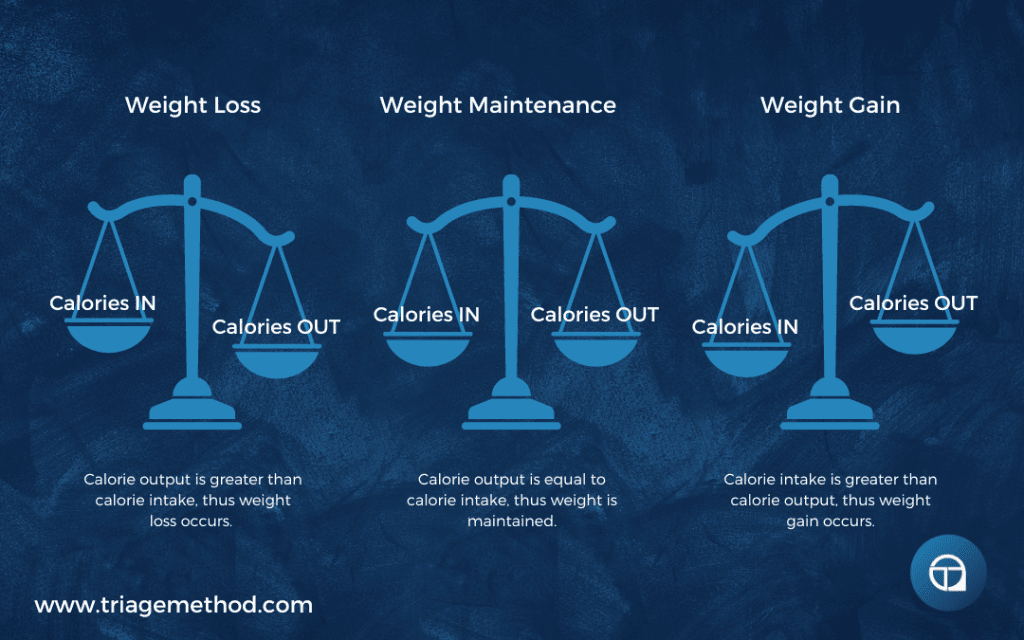Calories can be an incredibly confusing concept. I couldn’t tell you the amount of times I have been asked “what are calories?” or some variation of it. So in this article, we are going to clear up any confusion around calories. And by the end of it, you should have a pretty clear idea of what calories are, what determines your calorie needs, how to calculate your calorie requirements, and finally we will also discuss why calories aren’t everything and you do also need to work on diet quality.
So let’s get stuck in!
What Are Calories?
While we talk about calories as part of the diet, this can actually be quite confusing. You don’t eat calories, you eat food. You can’t see calories, and they are just an abstract concept. In the simplest terms, calories are units of energy. This is somewhat confusing, because we generally don’t measure energy in terms of calories, instead, we tend to use joules. What is even more confusing is the fact that there is a term Calories (with a capitalised C) and a term calorie (lowercase c) and they aren’t the same.
The term “calorie” (lowercase “c”) is a unit of measurement for energy. It represents the amount of energy required to raise the temperature of one gram of water by one degree Celsius (1°C). This is a relatively small unit of measurement and is not very practical when discussing the energy content of foods, as most foods contain much larger amounts of energy, like we would discuss when talking about nutrition.
Calories with a capitalised C, is actually much bigger than the lowercase c calories, 1000 times bigger to be precise. This is why it is often called a “kilocalorie”. The term “kilocalorie” (kcal) is equal to 1,000 calories (cal). When you see nutritional information on food labels or hear discussions about the energy content of foods, it is usually expressed in kilocalories (kcal) because the energy content of most foods is significantly higher than what can be represented conveniently using just calories (cal).
For example, when you hear that a chocolate bar contains 200 calories, it actually contains 200 kilocalories (kcal) of energy (200,000 small “c” calories).
So it is all quite confusing, but in truth, all you really need to understand is that calories are a measure of how much energy a specific foodstuff contains.
*For simplicities sake, when I am discussing calories going forward, you can just assume it is actually the type of calories we are actually interested in when discussing all this health and fitness stuff (i.e. kilocalories).
How Are Calories Measured?
When we talk about that chocolate bar containing 200 calories, this is actually only an estimation and there is actually likely some degree of error in the measurement. You see, calories are measured using a scientific method called bomb calorimetry. In a lab setting, a small sample of food is burned in a controlled environment, and the amount of heat released during combustion is measured. This heat release is then converted into calories (remember, when we defined what a calorie is, we related this back to heat energy).
Now, while bomb calorimetry is the gold standard for measuring calories, it’s not practical for everyday use. For this reason, the calorie content of most foods is determined using databases that compile information on the energy content of various ingredients and their proportions in recipes. Food manufacturers and government agencies often use these databases to calculate the caloric values displayed on nutrition labels.
As a result, the number of calories you read on a label and the number of calories actually in the food you are eating, can be incorrect. They likely aren’t off by a huge amount, but they certainly aren’t perfect.
*This is important to remember because people will obsess over getting their calories absolutely perfect. When they use an app like myfitnesspal, they will obsess over hitting their exact calorie target. However, in reality, this is never going to happen, as there is just too much variability in the actual measurement. So you would be best served not even getting into the mentality of trying to be absolutely perfect with hitting a calorie target.
Understanding The Calorie Content Of Macronutrients
The foods we eat are also not composed of all of the exact same stuff, and thus the energy we extract from them is not uniform. The three main macronutrients in our diet – carbohydrates, proteins, and fats – each provide a different number of calories per gram:
Carbohydrates: 4 calories per gram
Proteins: 4 calories per gram
Fats: 9 calories per gram
This means that for every gram of carbohydrates or proteins we consume, we get 4 calories of energy. However, for every gram of fat, we get 9 calories – more than twice the energy density of carbs and proteins. This is why high-fat foods tend to be more calorie-dense. (Alcohol contains 7 calories per gram!)
However, these are just averages, and while we use these figures for ease of use, the actual calorie content in any specific gram of any of the macronutrients may actually be quite different (although generally, the averages are within ~10% accuracy).
Now, while it is interesting to have this information, what we actually care about is how the body measures calories. Last time I checked, I am not a bomb calorimeter, I am a human. And hopefully, you are too.
How Does The Body Measure Calories
Calories measured in a bomb calorimeter are not the same as how the body treats them. Your body is not a combustion chamber, and it is less efficient than a bomb calorimeter. You generally don’t digest all of the food you eat, and this varies depending on the macronutrient. Overall, we probably only tend to digest and absorb ~90% of the calories we eat (it is probably around ~92% for fats, 87% for protein and 87% for carbs) under normal conditions.
So the calories you physically eat aren’t all being absorbed.
Further to this, your body doesn’t treat all the food the same, as some foods require more energy to break down and digest. Some foods require that you chew them a lot more before you can swallow them, some foods require more enzymes and gastric secretions to digest and absorb them, and ultimately, the calories that are measured in a bomb calorimeter are not the same as the calories your body measures as coming in.
This is also not the same as the amount of energy that eventually gets used in your cells, as there are many inefficiencies in energy metabolism overall too. A lot of the energy we consume does actually get lost as heat energy to the environment, and while this does actually help us maintain our body temperature, it does mean that the energy accounting is actually quite complicated.
Calories and Metabolism
Now, going back to our original question about calories and what they are, most people are asking this question because they want to be able to do something with that information. They want to understand calories better, so they can adjust their diet to better accomplish their goals. So it is important to understand what our calorie needs actually are, and by discussing this, we can actually wrap up a few loose ends with all of this calorie stuff. When we eat food, our bodies extract energy from it to perform various foundational functions such as breathing, pumping blood, and even thinking (yes, you are even burning calories by reading this!). These functions, collectively known as our basal metabolic rate (BMR), require a certain amount of energy to keep us alive and functioning even while at rest. Our BMR is heavily influenced by our overall body weight, especially by our overall level of muscle mass.
When we discuss metabolism, this is generally what people think they are discussing. The baseline amount of calories their body burns at rest. When someone says they have a slow or fast metabolism, they generally mean their BMR is high or low, or at least that is what they think they mean. However, when you equate for lean mass, there are actually very little difference between individuals in terms of the BMR (there are still differences, but they are minor in the grand scheme of things).
However, there are a host of other things that go into determining our calorie needs. Our total daily energy expenditure (TDEE) is the number of calories we burn in a day. Part of this is made up of our BMR, but the energy we burn moving is also accounted in it. This is generally broken down into 2 components, non-exercise activity thermogenesis (NEAT) and exercise activity thermogenesis (EAT). NEAT is all the energy you burn doing stuff that we generally wouldn’t consider exercise, such as fidgeting, walking around, moving back and forth on your chair etc. EAT is the energy you burn with purposeful exercise. When you eat foods, you also have to burn some energy to digest and absorb them. This is called the thermic effect of food (also referred to as the thermic effect of feeding)(TEF).
So when we talk about our calorie needs, this is actually what we are talking about. Our baseline daily calorie needs are equal to our total daily energy expenditure, but this is only if we are trying to match our calorie intake to our calorie output exactly. Which isn’t always the case!
You see, some people want to eat more calories so they can optimise performance and build more muscle. While some people want to eat fewer calories so they can lose body fat.
Understanding Caloric Balance
Which all brings us to our next point of understanding about calories, calorie balance. If we consume more calories than our bodies burn through daily activities and exercise, we end up with a caloric surplus, which ultimately, leads to weight gain. Conversely, if we consume fewer calories than we burn each day, we create a caloric deficit, which then leads to weight loss. If we consume the same amount of calories as we burn each day, then we are at our maintenance calories, as matching intake and expenditure leads to no change in body weight (i.e. weight maintenance).
This calorie balance equation, often referred to as the “calories in, calories out” (CICO) equation, is what people use to manipulate their body weight, ensure they are well-fuelled, and facilitate better health with nutrition.
It is important to understand that while we often think of this as a day-to-day balance, it is actually more appropriate to think of it over a longer period of time. Weight change doesn’t happen very quickly (although there can be some quite dramatic swings in weight, this is generally not actual fat gain/loss or muscle gain/loss, and is usually just water balance), and while you can gain/lose weight in a day, what we generally care about is the trend over a longer time period. This is important to remember, as one of the most common issues people fall victim to when trying to get their nutrition dialled in is eating in a deficit/surplus for a few days, and then doing the opposite for another few days. As a result, their calorie intake actually just hovers around maintenance.
For example, many people will try to lose weight and eat a calorie deficit Monday to Thursday, but then go out on a Friday night and between the alcohol and takeaway, they end up eating in a surplus for that day. The weekend is then a write-off, where they tell themselves they will start again Monday, and as a result, they overconsume food on both Saturday and Sunday. So when you total up their weekly CICO equation, despite aiming for weight loss, they actually end up eating at maintenance, or potentially even in a surplus.
As a result, many people think that there is something wrong with this CICO equation, and that it doesn’t work. In reality, most people just aren’t aware of the actual inputs that determine this equation.
On the “calories in” side of things, they don’t account for all the calories they are consuming (usually this is in the form of not accounting for cooking oils, sauces, or the days of the week where they eat excess calories).
On the “calories out” side of things, they tend to focus on there being something wrong with their BMR (i.e. they say they have a slow or fast metabolism), when in reality, they just aren’t properly accounting for their exercise calorie burn (EAT) and their general activity (NEAT). For most people, it is the NEAT side of things that gets ignored, and you would genuinely be surprised at how many calories you do actually burn when you just do stuff like trying to get 10,000 steps per day (we often use daily step count as a proxy measurement for NEAT, as you can’t exactly account for stuff like fidgeting).
How to Calculate Your Personalised Calorie Needs
Calculating calories might sound intimidating, but it’s actually a straightforward process. You can use an online calculator to determine your calorie needs, but this really only gives you an estimation. There are multiple calculations, but one that is frequently used is the Harris-Benedict equation, which is as follows:
For Men:
BMR = 88.362 + (13.397 × weight in kg) + (4.799 × height in cm) – (5.677 × age in years)
For Women:
BMR = 447.593 + (9.247 × weight in kg) + (3.098 × height in cm) – (4.330 × age in years)
Then, multiply your BMR by an activity factor:
- Sedentary (little or no exercise): BMR × 1.2
- Lightly active (light exercise/sports 1-3 days/week): BMR × 1.375
- Moderately active (moderate exercise/sports 3-5 days/week): BMR × 1.55
- Very active (hard exercise/sports 6-7 days a week): BMR × 1.725
- Super active (very hard exercise/sports, physical job, or training): BMR × 1.9
The result is your estimated daily calorie needs.
Performing this calculation will give you an estimate of your calorie needs, but we tend to not use this method a lot in our coaching. In general, a much better approach is to simply track your calorie intake over a period of a week to two weeks, and then see how your body weight has changed. If you lost weight, you have been eating in a deficit, and if you gained weight, you have been eating in a surplus. We expand on this method more in this article on how to set up your diet correctly, so I won’t spend too much time on this method here.
What I do want to mention however, is that it seems more scientific to use a calculator to work out your calories, it is actually generally less effective, and you will still need to adjust it based on how your body responds. Far too many people think that a calorie calculator they found online is the final word and it can’t be incorrect, but they very often are. Many people fall into the trap of thinking the calculator is correct, and that there is something wrong with them or they are doing something wrong, because they aren’t getting the results they want. So take the numbers a calculator spits out as a very rough estimate, and then adjust based on how your body actually responds.
Diet Quality vs. Diet Quantity
A very frequent critique of using calories to monitor and manipulate the diet is that all calories are not created equal. The types of food you choose to hit your calorie needs will have an impact on how your experience the diet, and the end results you get too. This is why we tend to only use calorie tracking to help guide the process of building a better diet pattern overall. It should not be a discussion about whether the quality of your diet is more important than the quantity of food you eat, both are important.
If you eat a diet that is calorie-appropriate but doesn’t contain all your macronutrient or micronutrient needs, that is obviously not going to be a good diet. Similarly, if you eat a super nutrient-dense diet, but you don’t eat a calorie-appropriate diet, then that is also not going to be a good diet.
So we generally want to try and get both our diet quality and diet quantity dialled into our needs. This is what we teach in our nutrition coaching certification course, and it is what we do with our coaching clients too.
Food selection and diet quality are important to get right, as you are unlikely to be able to stick to a diet if you are constantly hungry due to poor food choices. If you aren’t consuming the correct amount of macronutrients and/or micronutrients, then you are unlikely to get the health, body composition and/or performance benefits you want from the diet. So don’t get overly hung up on diet quantity (i.e. calorie counting) and neglect your overall diet quality.
What Are Calories Conclusion
Calories can seem like a bit of a mystery, but in reality, they are just a way to measure the energy you get from the diet. You can use your understanding of calories to manipulate your diet so that you can be better fuelled and/or so that you can manipulate your body weight. There are many pitfalls to being overly concerned with calories, and your should really just view them as a tool to help you improve your diet, rather than the end goal in and of itself.
If you want to understand the diet more comprehensively, then you should read our article about how to set up your diet, as that does fill in a lot of the other information you need to build a complete diet. If you need help with your diet, then getting online nutrition coaching may be for you. Finally, if you are interested in becoming a certified nutritionist, then our certification course may be of interest to you.
Calorie FAQs
How do age, gender, and activity level affect daily calorie needs?
Age: Calorie needs tend to decrease with age due to a decrease in muscle mass.
Gender: Men generally require more calories than women due to higher muscle mass and metabolic rate.
Activity Level: More active individuals need more calories to fuel their physical activity and maintain their body functions.
How can I calculate my daily calorie needs?
To estimate your daily calorie needs, you can use the Harris-Benedict equation:
For Men:
BMR = 88.362 + (13.397 × weight in kg) + (4.799 × height in cm) – (5.677 × age in years)
For Women:
BMR = 447.593 + (9.247 × weight in kg) + (3.098 × height in cm) – (4.330 × age in years)
Then, multiply your BMR by an activity factor:
- Sedentary (little or no exercise): BMR × 1.2
- Lightly active (light exercise/sports 1-3 days/week): BMR × 1.375
- Moderately active (moderate exercise/sports 3-5 days/week): BMR × 1.55
- Very active (hard exercise/sports 6-7 days a week): BMR × 1.725
- Super active (very hard exercise/sports, physical job, or training): BMR × 1.9
The result is your estimated daily calorie needs. As discussed in this article, calorie calculators should be seen as an estimate, and they need to be adjusted based on the real world.
What are “empty calorie” foods?
“Empty calorie” foods are foods that provide calories (energy) but lack essential nutrients like vitamins, minerals, and fibre. These foods often contribute to overall calorie intake without offering much nutritional value. Examples of empty calorie foods include sugary snacks, sugary beverages, sweets, pastries, and foods high in added fats without significant nutrients.
What are “negative calorie” foods?
“Negative calorie” foods refer to certain foods that require more energy to digest and metabolize than they provide in calories. In other words, the idea is that you could potentially burn more calories during digestion than you consume by eating these foods.
However, the concept of negative calorie foods is often overstated and not really scientifically supported. While some foods may have a relatively low-calorie content and provide fibre, water, and nutrients that promote satiety and metabolism, the overall energy expenditure during digestion is unlikely to result in a net negative calorie intake.
Are there specific foods that can boost my metabolism and help me burn more calories?
While no single food can drastically boost metabolism on its own, some foods may have a slight effect on increasing metabolic rate. This is often referred to as the “thermic effect of food,” which is the energy expenditure required for digestion, absorption, and processing of nutrients.
Including these foods in your diet might help in burning a few more calories:
- Protein-rich foods: Protein has a higher thermic effect compared to fats and carbohydrates. It requires more energy to digest, which can slightly increase metabolic rate. To get more protein in the diet, try to include lean meats, poultry, fish, eggs, legumes, and dairy products.
- Spicy foods: Compounds like capsaicin found in chilli peppers can mildly increase metabolic rate and promote fat oxidation. But the overall effect is quite minimal.
- Coffee: Caffeine, found in coffee, can slightly boost metabolism and enhance fat oxidation.
- Green tea: Green tea contains compounds like catechins that may enhance thermogenesis and fat oxidation.
- Fruits, Vegetables and Whole Grains: Fiber-rich foods like fruits, vegetables and whole grains can slightly increase metabolic rate due to their complex carbohydrate content.
- Omega-3 fatty acids: These types of fats, typically found in fatty fish like salmon, may ever so slightly influence metabolic rate.
Overall, I really wouldn’t be looking for a wonder food to boost your metabolism, instead, I would focus on good nutrition and exercise practices.
References and Further Reading
Osilla EV, Safadi AO, Sharma S. Calories. 2022 Sep 12. In: StatPearls [Internet]. Treasure Island (FL): StatPearls Publishing; 2023 Jan–. PMID: 29763084. https://pubmed.ncbi.nlm.nih.gov/29763084/
Hall KD, Farooqi IS, Friedman JM, Klein S, Loos RJF, Mangelsdorf DJ, O’Rahilly S, Ravussin E, Redman LM, Ryan DH, Speakman JR, Tobias DK. The energy balance model of obesity: beyond calories in, calories out. Am J Clin Nutr. 2022 May 1;115(5):1243-1254. doi: 10.1093/ajcn/nqac031. PMID: 35134825; PMCID: PMC9071483. https://pubmed.ncbi.nlm.nih.gov/35134825/

Paddy Farrell
Hey, I'm Paddy!
I am a coach who loves to help people master their health and fitness. I am a personal trainer, strength and conditioning coach, and I have a degree in Biochemistry and Biomolecular Science. I have been coaching people for over 10 years now.
When I grew up, you couldn't find great health and fitness information, and you still can't really. So my content aims to solve that!
I enjoy training in the gym, doing martial arts and hiking in the mountains (around Europe, mainly). I am also an avid reader of history, politics and science. When I am not in the mountains, exercising or reading, you will likely find me in a museum.




